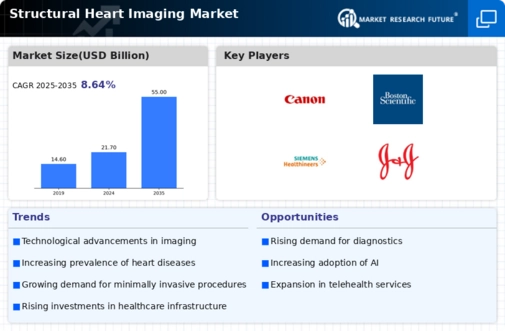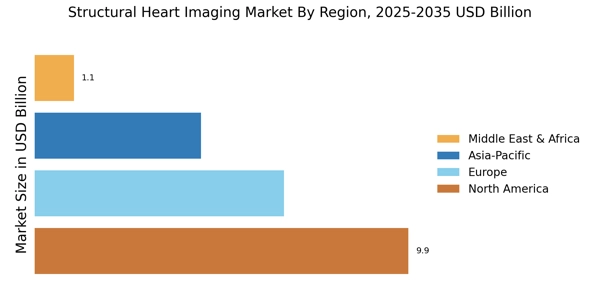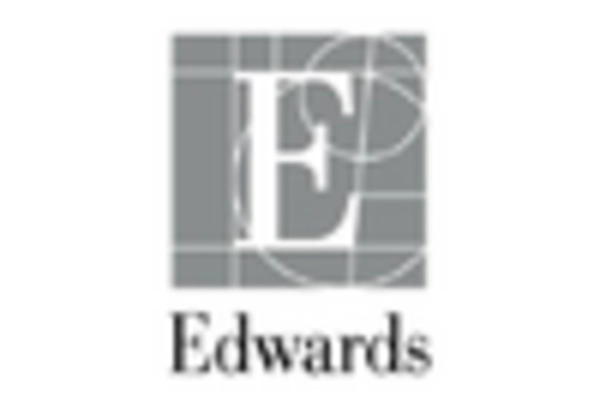Rising Prevalence of Cardiovascular Diseases
The increasing incidence of cardiovascular diseases is a primary driver for the Structural Heart Imaging Market. As populations age and lifestyle-related health issues become more prevalent, the demand for advanced imaging solutions rises. According to recent data, cardiovascular diseases account for a substantial percentage of global mortality, necessitating effective diagnostic tools. This trend is likely to propel investments in structural heart imaging technologies, as healthcare providers seek to enhance diagnostic accuracy and treatment outcomes. The growing awareness of heart health among patients further fuels this demand, leading to a more proactive approach in managing cardiovascular conditions. Consequently, the Structural Heart Imaging Market is expected to experience significant growth as healthcare systems adapt to these changing dynamics.
Technological Innovations in Imaging Techniques
Technological advancements in imaging techniques are transforming the Structural Heart Imaging Market. Innovations such as 3D echocardiography, cardiac MRI, and advanced CT imaging are enhancing the precision and efficiency of heart diagnostics. These technologies allow for better visualization of cardiac structures, which is crucial for accurate diagnosis and treatment planning. The market has seen a surge in the adoption of these advanced imaging modalities, with a notable increase in the number of procedures performed annually. As healthcare providers continue to invest in state-of-the-art imaging equipment, the Structural Heart Imaging Market is poised for substantial growth. The integration of these technologies not only improves patient outcomes but also streamlines workflow in clinical settings, making them indispensable in modern cardiology.
Growing Demand for Minimally Invasive Procedures
The rising preference for minimally invasive procedures is significantly influencing the Structural Heart Imaging Market. Patients increasingly favor treatments that offer reduced recovery times and lower risks of complications. This trend is prompting healthcare providers to adopt advanced imaging technologies that facilitate these procedures. For instance, transcatheter aortic valve replacement (TAVR) and other catheter-based interventions rely heavily on precise imaging for successful outcomes. As the number of such procedures continues to rise, the demand for structural heart imaging solutions is expected to grow correspondingly. This shift towards less invasive options not only enhances patient satisfaction but also drives innovation within the Structural Heart Imaging Market, as manufacturers strive to develop imaging tools that support these evolving treatment paradigms.
Increased Investment in Healthcare Infrastructure
The expansion of healthcare infrastructure is a crucial driver for the Structural Heart Imaging Market. Governments and private entities are investing significantly in healthcare facilities, particularly in emerging markets. This investment is aimed at improving access to advanced medical technologies, including structural heart imaging solutions. As new hospitals and diagnostic centers are established, the demand for sophisticated imaging equipment is likely to rise. Furthermore, the emphasis on enhancing healthcare quality and patient outcomes is pushing institutions to adopt cutting-edge imaging technologies. This trend is expected to create a favorable environment for the Structural Heart Imaging Market, as more healthcare providers seek to integrate advanced imaging capabilities into their services.
Regulatory Support for Advanced Imaging Technologies
Regulatory bodies are increasingly supporting the development and adoption of advanced imaging technologies within the Structural Heart Imaging Market. Initiatives aimed at expediting the approval process for innovative imaging devices are becoming more common. This regulatory support is crucial for manufacturers looking to bring new products to market quickly. As a result, the pace of innovation in structural heart imaging is likely to accelerate, leading to a wider array of options for healthcare providers. Additionally, favorable reimbursement policies for advanced imaging procedures are encouraging hospitals to invest in these technologies. This supportive regulatory environment is expected to bolster the Structural Heart Imaging Market, facilitating growth and enhancing patient care.


















Leave a Comment